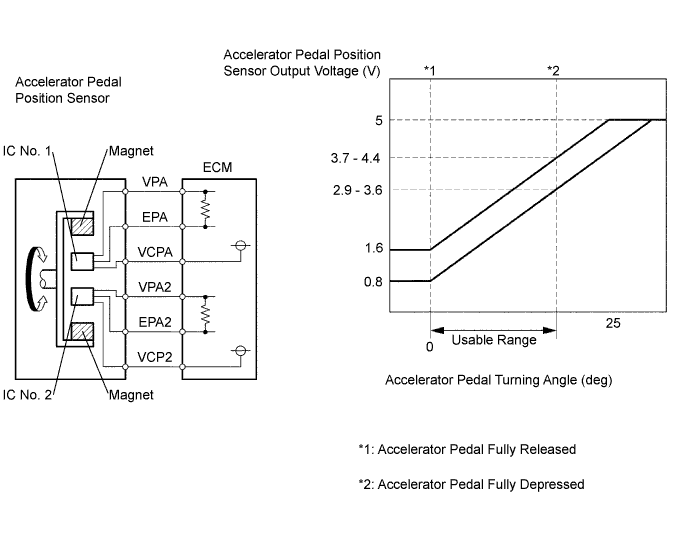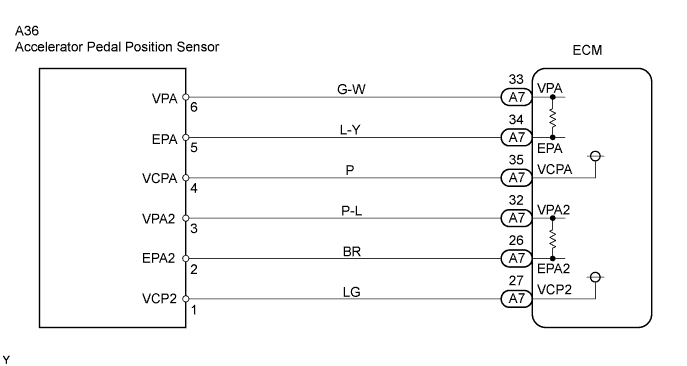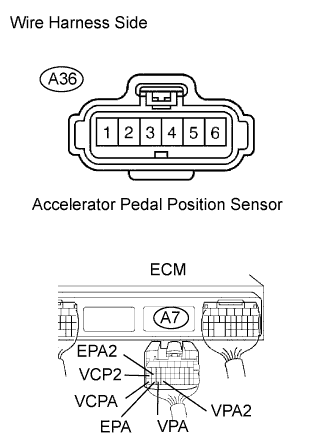Dtc P2121 Throttle / Pedal Position Sensor / Switch D Circuit Range / Performance
Engine. Lexus Gs430, Gs300. Uzs190 Grs190
DESCRIPTION
MONITOR DESCRIPTION
FAIL-SAFE
WIRING DIAGRAM
INSPECTION PROCEDURE
READ VALUE USING INTELLIGENT TESTER (ACCEL POS #1 AND ACCEL POS #2)
CHECK WIRE HARNESS (ACCELERATOR PEDAL POSITION SENSOR - ECM)
REPLACE ACCELERATOR PEDAL
CHECK OUTPUT DTC (ACCELERATOR PEDAL POSITION SENSOR DTCS ARE OUTPUT AGAIN)
DTC P2121 Throttle / Pedal Position Sensor / Switch "D" Circuit Range / Performance |
DESCRIPTION
- HINT:
- The Electronic Throttle Control System (ETCS) does not use a throttle cable.
- The accelerator pedal position sensor is a non-contact type.
- The ETCS does not use a throttle cable.
The accelerator pedal position sensor is mounted on the accelerator pedal bracket and has 2 sensor circuits: VPA (main) and VPA2 (sub). This sensor uses Hall-effect elements to yield accurate signals, even in extreme driving conditions, such as at high speeds as well as very low speeds. The voltage, which is applied to terminals VPA and VPA2 of the ECM, varies between 0 V and 5 V in proportion to the operating angle of the accelerator pedal (throttle valve). A signal from VPA indicates the actual accelerator pedal opening angle (throttle valve opening angle) and is used for engine control. A signal from VPA2 conveys the status of the VPA circuit and is used to check the accelerator pedal position sensor itself.
The ECM monitors the actual accelerator pedal opening angle (throttle valve opening angle) through the signals from VPA and VPA2, and controls the throttle actuator according to these signals.

DTC No.
| DTC Detection Condition
| Trouble Area
|
P2121
| Difference between VPA and VPA2 is less than 0.4 V, or more than 1.2 V for 0.5 seconds (1 trip detection logic)
| - Accelerator position sensor
- ECM
|
- HINT:
- When any of these DTCs are set, check the accelerator pedal position sensor voltage by entering the following menus on the intelligent tester: Powertrain / Engine / Data List / Primary / Accelerator Position No. 1 and Accelerator Position No. 2.
Trouble Areas
| Accelerator Position No. 1
When AP Released
| Accelerator Position No. 2
When AP Released
| Accelerator Position No. 1
When AP Depressed
| Accelerator Position No. 2
When AP Depressed
|
VCP circuit open
| 0 to 0.2 V
| 0 to 0.2 V
| 0 to 0.2 V
| 0 to 0.2 V
|
Open or ground short in VPA circuit
| 0 to 0.2 V
| 1.2 to 2.0 V
| 0 to 0.2 V
| 3.4 to 5.0 V
|
Open or ground short in VPA2 circuit
| 0.5 to 1.1 V
| 0 to 0.2 V
| 2.6 to 4.5 V
| 0 to 0.2 V
|
EPA circuit open
| 4.5 to 5.0 V
| 4.5 to 5.0 V
| 4.5 to 5.0 V
| 4.5 to 5.0 V
|
Normal condition
| 0.5 to 1.1 V
| 1.2 to 2.0 V
| 2.6 to 4.5 V
| 3.4 to 5.0 V
|
- HINT:
- Accelerator pedal positions are expressed as voltages.
- AP stands for Accelerator Pedal.
MONITOR DESCRIPTION
The accelerator pedal position sensor is mounted on the accelerator pedal bracket. The accelerator pedal position sensor has 2 sensor elements, VPA and VPA2, each with their own signal outputs. VPA is used to detect the actual accelerator pedal angle (used for engine control) and VPA2 is used to detect malfunctions in VPA. When the difference between the voltage outputs of VPA and VPA2 deviates from the standard, the ECM determines that the accelerator pedal position sensor is malfunctioning. The ECM turns on the MIL and sets the DTC.
FAIL-SAFE
The accelerator pedal position sensor has 2 (main and sub) sensor circuits. If a malfunction occurs in either of the sensor circuits, the ECM detects the abnormal signal voltage difference between the 2 sensor circuits and changes to limp mode. In limp mode, the functioning circuit is used to calculate the accelerator pedal opening angle to allow the vehicle to continue driving. If both circuits malfunction, the ECM regards the opening angle of the accelerator pedal as being fully closed. In this case, the throttle valve remains closed as if the engine is idling.If a "pass" condition is detected and the engine switch is turned off, the fail-safe operation stops and the system returns to normal.
WIRING DIAGRAM
INSPECTION PROCEDURE
- HINT:
- Read freeze frame data using the intelligent tester. Freeze frame data records the engine conditions when malfunctions are detected. When troubleshooting, freeze frame data can help determine if the vehicle was moving or stationary, if the engine was warmed up or not, if the air-fuel ratio was LEAN or RICH, and other data from the time the malfunction occurred.
- This DTC relates to the accelerator pedal position sensor.
| 1.READ VALUE USING INTELLIGENT TESTER (ACCEL POS #1 AND ACCEL POS #2) |
Connect the intelligent tester to the DLC3.
Turn the engine switch on (IG) and turn the tester ON.
Enter the following menus: Powertrain / Engine / Data List / Primary / Accelerator Position No. 1 and Accelerator Position No. 2.
Read the value.
- Standard voltage:
Accelerator Pedal Operations
| Accelerator Position No. 1
| Accelerator Position No. 2
|
Released
| 0.5 to 1.1 V
| 1.2 to 2.0 V
|
Depressed
| 2.6 to 4.5 V
| 3.4 to 5.0 V
|
| 2.CHECK WIRE HARNESS (ACCELERATOR PEDAL POSITION SENSOR - ECM) |
Disconnect the A36 accelerator pedal position sensor connector.
Disconnect the A7 ECM connector.
Measure the resistance of the wire harness side connectors.
- Standard resistance:
Tester Connections
| Specified Conditions
|
A36-1 (VCP2) - A7-27 (VCP2)
| Below 1 Ω
|
A36-2 (EPA2) - A7-26 (EPA2)
| Below 1 Ω
|
A36-3 (VPA2) - A7-32 (VPA2)
| Below 1 Ω
|
A36-4 (VCPA) - A7-35 (VCPA)
| Below 1 Ω
|
A36-5 (EPA) - A7-34 (EPA)
| Below 1 Ω
|
A36-6 (VPA) - A7-33 (VPA)
| Below 1 Ω
|
A36-1 (VCP2) or A7-27 (VCP2) - Body ground
| 10 kΩ or higher
|
A36-2 (EPA2) or A7-26 (EPA2) - Body ground
| 10 kΩ or higher
|
A36-3 (VPA2) or A7-32 (VPA2) - Body ground
| 10 kΩ or higher
|
A36-4 (VCPA) or A7-35 (VCPA) - Body ground
| 10 kΩ or higher
|
A36-5 (EPA) or A7-34 (EPA) - Body ground
| 10 kΩ or higher
|
A36-6 (VPA) or A7-33 (VPA) - Body ground
| 10 kΩ or higher
|
| | REPAIR OR REPLACE HARNESS AND CONNECTOR |
|
|
| 3.REPLACE ACCELERATOR PEDAL |
| 4.CHECK OUTPUT DTC (ACCELERATOR PEDAL POSITION SENSOR DTCS ARE OUTPUT AGAIN) |
Clear the DTCs (Click here).
Start the engine and allow the engine to idle for 15 seconds or more.
Read DTCs.
- Result:
Display (DTC output)
| Proceed to
|
P2121
| A
|
No output
| B
|



